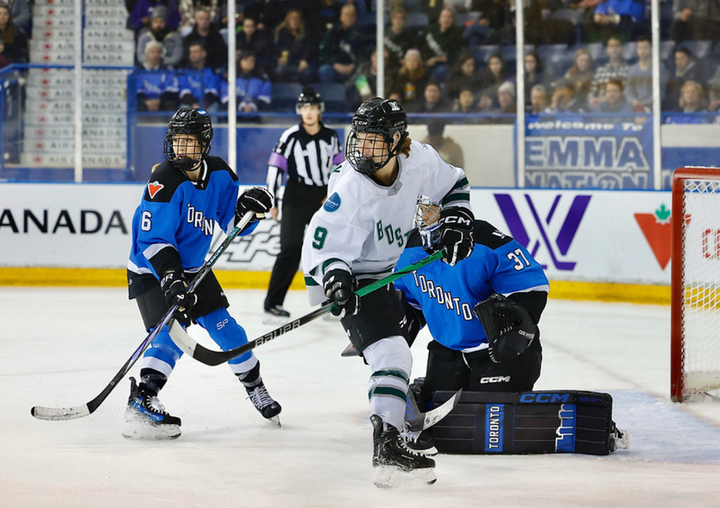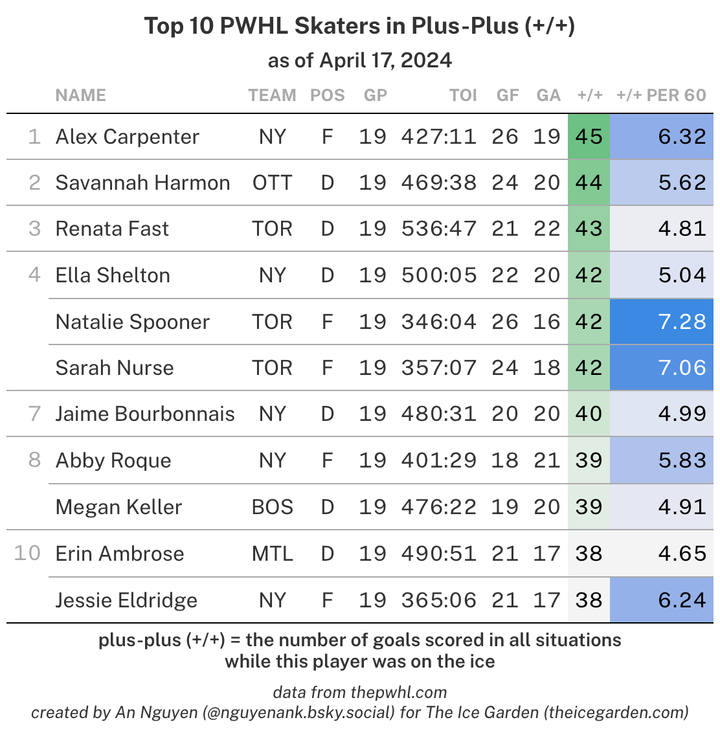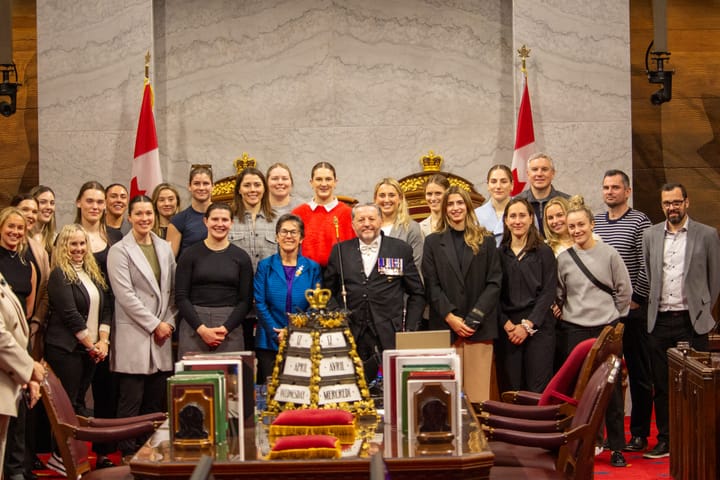Why the NWHL and PWHPA getting serious about analytics is important
Some words about numbers
On Dec. 7, the NWHL announced its partnership with Stathletes to provide data for all six of the league’s teams for the Lake Placid season. Ten days later, the PWHPA announced that Sportlogiq had become its official data partner.
And, just like that, the small world of women’s hockey analytics found itself in the spotlight — even if only for a moment.
Related
Women’s Hockey Analytics Primer
As someone who has spent a lot of time working with women’s hockey data, I’ve gotten the impression that most fans are, at best, ambivalent about analytics. To be clear, I don’t pretend to know how anyone but myself feels about anything, but I’ve seen the pageviews and I know how small the women’s hockey data community is. At the moment, the number of people regularly creating data and/or tools or visualizations for public consumption could comfortably fit into two penalty boxes. Three years ago, you wouldn’t need a second box.
So, where does this ambivalence come from?
Well, analytics in women’s hockey is in its infancy. It’s different. One needs only to count the number of eyes that roll in a sports bar with an NHL game on the TV when Corsi is mentioned to appreciate the friction analytics can cause among those who follow the men’s game. There’s a lot less friction in the women’s hockey space — surprise, surprise — but analytics isn’t exactly being embraced. Yet.
Recently retired Team USA captain Meghan Duggan spoke about some of the attitudes surrounding data in hockey at the MIT Sloan Sports Analytics Conference in 2019. She was speaking more to her perspective as a player but one can easily see how it resonates with how fans can and often do feel.
“I think, as a player, I see this in two different ways,” Duggan said. “On one hand, where there’s a lack of buy-in from players and coaches I can see because there’s so much about all sports, but hockey specifically — there’s something so magical about playing the game, about not knowing every single little thing. [It’s] the magic of sports. Crazy things happen all the time for reasons that nobody can explain. I love that about sports. I love that about hockey.
“On the flip side of that,” she continued. “I’m the type of athlete if there’s a way that I can be better by this much I want to know. I want to be able to work at that.”
Most fans, coaches, and players would agree that they want women’s hockey analytics to grow but the growth thus far has been underwhelming. The gutting reality of professional women’s sports is that resources are often too scarce for teams and/or franchises to invest in data or to provide stats to the public that go beyond final scores. Data simply isn’t a priority. Travel expenses, gear, health insurance, and salaries are priorities.
Having data spend so much time on the back burner does come at a cost though. While the popularity of women’s and girls’ hockey continues to grow across the globe, data and data-driven analysis are lagging behind. There simply aren’t enough resources invested in data or people working on it.
From Jacob Knox of the Power Plays newsletter on May 27:
Unfortunately, there is an information gap in the sports world. At almost every level of every sport, the availability and richness of statistics in women’s sports are lacking compared to the men’s game.
Every game of hockey is filled with events. Thousands of events. Dump-ins, line changes, penalties, shot attempts, saves, pass attempts, zone entries and exits, and puck battles. With analytics, we can quantify each event to tell the story of a shift, play, game, or season. By analyzing that data we can better understand the events that shape the outcome of the game as well as predict the performance of players and teams. And that’s just the tip of the iceberg.
Analytics is the scientific means of quantifying the magic that is hockey, which is a particularly bold endeavor because, as every fan knows, hockey is filled with magic, chaos, and randomness.
For me, women’s hockey data represents a lot of different things. First and foremost, it represents a way to better understand a game that has been underserved by the media and analysts since its inception. Women’s hockey is all about possession, tactics, and team play but, at the moment, we don’t have a lot of data to work with to support these claims. We don’t have a lot of data to work with at all, really. And that’s a shame because if more people took analytics in women’s hockey more seriously we could learn more about the sport as a whole.
There’s a lot we can learn from analyzing the numbers. Diving into the data can provide us with the means to answer important questions and to better analyze and contextualize the performance of players and teams. How does the rule against body checking affect zone entries in women’s hockey? How can teams implement data to better prepare for games and specific opponents? How dependent is Team X on its power play to create offense compared to Team Y?
It can also help us investigate issues that are critical to women’s hockey, including the sport’s high rate of concussions which exceeds what we see in men’s wrestling, football, and hockey (NCAA, 2014). Or analyzing how athletes develop and when they reach their prime playing years.
Meghan Chayka highlighted how data and data modeling can highlight the performances of players who might not otherwise show up in the box score in an interview she did with the IIHF following her work at the PyeongChang Olympics:
A lot of the data points that don’t show up on box scores are highly relevant in analysis or modelling. So for example, even when you’re talking about a first pass, pass completion, was there pressure? What areas of the ice is she passing from? Does the possession that she starts end in a goal? Those are all really important questions that won’t show up on a box score necessarily. But you know that defenceman is doing a good job for you from an offensive side if they start a lot of possessions that end up with good scoring chances.
You get the idea. Data and the analysis of it can provide us with a deeper understanding of the game in countless ways.
I’ve spoken with dozens of players over the years and many of them have gone out of the way to talk about stats — and it’s not just because they want to make sure they’re credited with a secondary assist that a scorekeeper may have missed. In a recent interview I had with Jillian Dempsey, she noted that she understood that faceoffs don’t necessarily correlate to possession but found that when her team is winning more faceoffs they tend to win more often. Sounds like something someone should dig into.
Generally speaking, many players care about data because, as Duggan said, it’s a tool that they can put to use to improve. Players like Duggan and Dempsey care because they are elite athletes. They didn’t get to the level they are at by dismissing tools that could help them or their teams perform better. They want to be better and they want the sport they love to grow. Analytics is a valuable tool to have on your belt to do that and a whole lot more.
“With the national team for the last 12 years I’ve been on the team [preparation] depends a little bit on the coach that we have and what their styles are,” Duggan said at the MIT Sloan SAC. “Preparations for us over the years have changed tremendously. With that being said, that’s something I’d be interested in the national team having more access to some of the data and the analytics to streamline the preparation. I think it would help a lot in that area.”
In the PWHPA’s release of its partnership with Sportlogiq, Karell Emard described what having that data means and could mean to her and her peers. “As a PWHPA player, iCE gives us access to tools that improve individual aspects of our game and analyze our team’s performance,” Emard said. “To be able to have the same type of advanced analytics and video tagging as the NHL receives is simply amazing.”
On the NWHL side of things, Stathletes is providing data and insights to the league’s teams and Chayka has gone out of her way to engage with the women’s hockey analytics community. These things matter. They matter a lot.
Data is also an important way to collect and preserve history. Chayka hit the nail on the head in an interview she did with The Hockey News when she said, “Unless you show up on a box score in women’s hockey, traditionally it’s lost. Even a lot of the game tape is hard to find. So there’s a lot of players who don’t have an understanding of their full play or their tournament or game that I think deserve a lot more spotlight – as the men’s game gets.”
I have lost sleep thinking about how much women’s hockey history we’ve lost over the years. I spoke about this at length on a recent episode of the Founding 4 Podcast with Erica Ayala. How much tape do we have of Hall of Famer Angela James playing hockey? Where are the box scores of the games that she played in? These issues aren’t exclusive to the ghosts of women’s hockey past. The CWHL’s site, with all of its stats, is down. The PWHPA didn’t publish box scores for its Dream Gap Tour games last season and video of some NWHL games has been lost forever. We have a lot of work to do.
It hurts to think about how much history we’ve lost that we may never be able to recover. I’ve found that the best remedy for that pain is to take measures to prevent it. Take the sport and the stats seriously. We can use data to make noise and draw more eyeballs to the sport, these athletes, and their achievements. I like to think that doing so could help pave the way for more women being enshrined in the Hockey Hall of Fame, the IIHF Hall of Fame, and similar institutions.
The numbers matter.
Members of the media can implement analytics in their work to become better storytellers and analysts. Teams, coaches, and players can use data to adjust their tactics, study the game, and unlock their potential. Fans can use stats to enrich their experience and find a new appreciation for specific players or aspects of the game that might otherwise go overlooked. The applications are endless. All we need is the data and the people willing and able to work with it.
This isn’t about the NWHL versus the PWHPA or Stathletes versus Sportslogiq, and it shouldn’t be. It’s about resources and knowledge being made available to the women who are shaping the sport. That’s huge.
Hopefully, some of that data will also be made available to the public through social media and other means. In my opinion, the best kind of data in women’s hockey is the kind that’s made available to everyone. There’s so much to learn about the game and so little for those who are passionate about it to work with.
There’s a chance that the work that Stathletes and Sportslogiq are doing with the NWHL and PWHPA could spark an interest in sports data for thousands of women’s hockey fans. That’s huge. We need more people involved and invested in this field. We need to close the gap between women’s hockey analytics and men’s hockey analytics. The sport and its athletes deserve it.
We need more people who are passionate about making stats accessible to the public like Beau Marchwick. We need more people who excel at data-driven analysis like Carlie Markey and Spencer Fascetta. We need more people developing tools like Nayan Patel and Mikael Nahabedian. We need more Shayna Goldmans making visualizations with women’s hockey data. We need more champions of women’s hockey data like Alyssa Longmuir and people with resources like Meghan Chayka to get involved. And, if you’ve read this far and find yourself convinced (if you weren’t already) that data and analytics are integral to women’s hockey, we need more people like you.
We need to move the puck forward. Even if only for a moment.





Comments ()